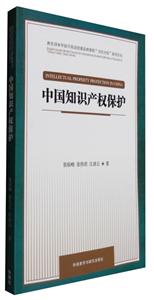预估到手价是按参与促销活动、以最优惠的购买方案计算出的价格(不含优惠券部分),仅供参考,未必等同于实际到手价。
-
>
鲍勃·迪伦诗歌集:1961-2012:典藏版
-
>
双城记-英文版
-
>
四级词汇词根+联想记忆法:乱序版
-
>
The secret garden
-
>
哈克贝利.费恩历险记/床头灯英语.2000词读物(英汉对照)
-
>
10000德语分类词汇联想记忆
-
>
英语词汇全书
中国知识产权保护 版权信息
- ISBN:9787513570244
- 条形码:9787513570244 ; 978-7-5135-7024-4
- 装帧:一般胶版纸
- 册数:暂无
- 重量:暂无
- 所属分类:>
中国知识产权保护 本书特色
《中国知识产权保护》系同济大学“当代中国丛书”系列教材之一,全部内容采用英文撰写并经专家审阅。本书内容权威详实,语言精炼地道,向读者详细介绍了中国知识产权保护的基本情况,可作为外国学生或读者学习了解中国知识产权保护的教材使用。
中国知识产权保护 内容简介
The origin and primary aim of this work is to offer a textbook covering the basic information about Chinese intellectual property to foreign students with or without a legal background. With thesupport of Tongji University, we, the three authors of this textbook, have had the opportunity overthe past four years to offer a course named “Chinese Intellectual Property Protection”. It is one of the nine “General Courses Given in English”, which are open to all the international studentsat Tongji University, and seeks to present a general knowledge on the topic in China. During theteaching, we found it necessary to write a textbook which can meet the requirements of this course and help foreign students to get a better understanding of the landscape of Chinese intellectual property.
中国知识产权保护 目录
1. An Introduction to Intellectual Property
1.1 The Concept oflntellectual Property
1.2 Main Branches oflntellectual Property
1.3 Reason to Protect Lntellectual Property
1.4 Main Features oflntellectual Property
2. An Introduction to Intellectual Property Legislation in China
2.1 HistoricaIBackground
2.2 Legislative Framework and Recent Trends
3. An Introduction to Intellectual Property Enforcement in China
3.1 Dualor ParalleISystem
3.2 JudiciaIEnforcement
3.3 Administrative Enforcement
Questions for Discussion
Chapter 2 Introduction to Chinese Patent Law
1. What Is a Patent
2. Patent Types and Terms ofProtectio
2.1 Three Types ofPatents
2.2 Invention
2.3 UtilityModel
2.4 Design
2.5 Terms ofthe Three Types ofPatent
3. PatentAuthority
3.1 Intemational Obligation to Offer NationalIP Services
3.2 Two-Tier Administrative Authority
3.3 State Intellectual Property Office (SIPO)
3.4 Local IP Office
4. Sources of Chinese Patent Law
4.1 Principle Legal Provisions Concerning Patent Law
4.2 Adoption of the Patent Law and the Amendments
4.3 Accession to IntemationaITreaties
Questions for Discussion
Chapter 3 Patent Eligibility and Patentability
1. Patent Eligibility
1.1 Consistency with Law, Morality and Public Interest
1.2 Patentable Subject Matter
1.3 Patent Eligibility ofComputer Software & Software-Related
Business Method
2. Patentab
2.1 Invention Patents and Utility Model Patents
2.2 DesignPatents
Questions for Discussion
Chapter 4 Proprietorship,Assignment and License of Pate nts
1. Relevant Players
1.1 Inventors or Designers
1.2 Patent Applicants
1.3 Patentees
1.4 Patent Licensees
1.5 Patent Assignees
2. Service Invention-Creation and Non-Service Invention-Creation
2.1 Servicelnvention-Creation.,
2.2 Non-Servicelnvention-Creatio
2.3 Contract Freedom to Fix the Nature of an Invention-Creation
2.4 Employee's Right to Claim Reward and Remuneration
3. Co-Ownership and Commissionlnventio
4. Patent Assignm ent
4.1 General
4.2 Formality
4.3 Assignment to a Foreigner
……
Chapter 5 Patent Prosecution and Invalidation in China
Chapter 6 Patent Infringement, Defense and Remedies
Chapter 7 Introduction to Copyright Law
Chapter 8 Ownership of Copyright
Chapter 9 Subject Matter of Copyright
Chapter 10 Rights of the Copyright Owners
Chapter 11 Rights Related to the Copyright
Chapter 12 The Terms of Copyright Protection
Chapter 13 Collective Management of Copyright
Chapter 14 Copyright Enforcement
Chapter 15 Trademark Registration in China
Chapter 16 Unfair Competition & Trademark Infringement
Chapter 17 How to Protect Well-Known Trademarks in China
Annex 1: Patent Law of the People's Republic of China (source: WIPO website)
Annex 2: Copyright Law of the People's Republic of China (source: WIPO website)
Annex 3: Trademark Law of the People's Republic of China (source: WIPO website)
中国知识产权保护 节选
《中国知识产权保护》: 2.3 Description According to Art.26, Para.3 of the Patent Act, the description must set forth the invention or utility modelin a manner sufficiently clear and complete so as to enable "a person skilled in the relevant field of technology" to carry it out. 2.3.1 A Person Skilled in the Art "A person skilled in the relevant field of technology" is largely consistent with the notions of "a person skilled in the art" or "a person in the art" or "a person holding/having ordinary skill in the art (PHOSITA)" in foreign laws and international conventions.The State IP Office's Guidelines for Patent Examination point out that "person skilled in the art" is a fictional person who is considered to have the normal skills and knowledge in a particular technical field, however, without being a genius. 2.3.2 Requirement of "Sufficiently Clear and Complete" "Sufficiently clear and complete" means the description must disclose the invention or utility model in a manner that enables a person skilled in the art to carry out the invention or utility model depending merely on the description,without further creative efforts of his/her own.The applicant must clearly describe the subject matter of the invention-creation, i.e., the technical problem the invention or utility model aims to solve,the technical solution adopted to solve this problem, and the advantageous effects of the invention or utility model. Meanwhile, the expression of the description must be precise, without ambiguity or equivocation. As to the completeness requirement, the description must include all the technical contents that are necessary for understanding and carrying out the invention or utility model. Actually, the arrangement ofthe form and content of the description (see below) is sort of tool to have the drafter met the requirement of completeness.The requirement of clarity and completeness also request that the description of the invention or utility model must use standard terms and be in clear wording, and must not contain such references to the claims as: "as described in the claim... ", nor does it contain commercial advertising. ……
- >
推拿
推拿
¥12.2¥32.0 - >
小考拉的故事-套装共3册
小考拉的故事-套装共3册
¥36.7¥68.0 - >
山海经
山海经
¥13.6¥68.0 - >
唐代进士录
唐代进士录
¥17.1¥39.8 - >
名家带你读鲁迅:故事新编
名家带你读鲁迅:故事新编
¥13.0¥26.0 - >
我从未如此眷恋人间
我从未如此眷恋人间
¥21.4¥49.8 - >
二体千字文
二体千字文
¥16.0¥40.0 - >
人文阅读与收藏·良友文学丛书:一天的工作
人文阅读与收藏·良友文学丛书:一天的工作
¥16.0¥45.8
-
六朝文选注
¥17.9¥56 -
出发(IB中文ab initio课本1)
¥131.5¥239 -
文化卷-商务中文案例教程
¥18.7¥89 -
2022图书×抽奖盲袋
¥9.9¥25 -
2023读书月阅读盲盒——天黑,闭眼,刀谁?
¥42.3¥158















